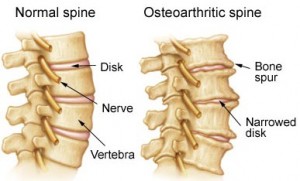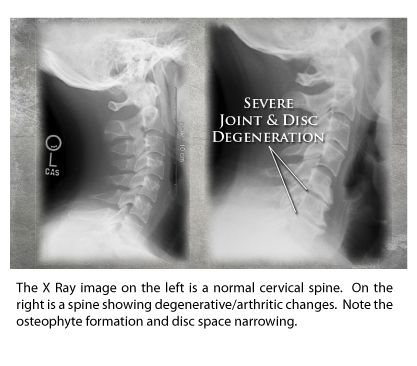The Link Between Tight Joints and Spinal Arthritis
 Degenerative conditions of the spine such as spinal arthritis and degenerative disc disease can be significant sources of spinal pain and stiffness. One of the most common (but also preventable) causes of joint degeneration is abnormal motion of the spine. This article will review how limitation in joint motion leads to cartilage degeneration, a condition referred to as a immobilization degeneration.
Degenerative conditions of the spine such as spinal arthritis and degenerative disc disease can be significant sources of spinal pain and stiffness. One of the most common (but also preventable) causes of joint degeneration is abnormal motion of the spine. This article will review how limitation in joint motion leads to cartilage degeneration, a condition referred to as a immobilization degeneration.
The Healthy Spine
The spinal joints are incredibly adaptable structures. In an attempt to meet the needs and demands of daily life joint cartilage as well as the surrounding ligaments, joint capsules, tendons, and muscles, are in a continual state of tissue remodelling and reorganization. This adaptation is driven by the amount of stress placed on the system. When we have just the right amount of stress it stimulates the body to build stronger and healthier tissue. However if the stress falls outside of the normal physiological window (for example, if the stress is too much or too little) It can cause the tissue to become weak and degenerate.
The Arthritic Spine
The joints of the spine are designed to bend, twist, and move. Not only does this allow us to alter our body posture and accomplish countless activities, but this movement also creates a positive stress on the joints which stimulates the body to build and maintain strength, health, and tissue integrity of the spinal joints. However, when the soft tissue surrounding the joint become tight or inflexible it will restrict the normal range of motion of the spinal joints. Not only can this situation result in symptoms such as pain and stiffness, but if the joint fails to move through its normal physiological range of motion it will also lead to a loss of the adaptive stimulus needed to direct tissue growth and adaptation. The result is a loss of strength, size, and structural integrity of joint cartilage, as well as the surrounding soft tissue.
It is interesting to note that complete a mobilization of a joint is not required for this tissue degeneration to occur, nor does the loss of joint motion need to occur for a prolonged period of time. In fact even a temporary loss in normal joint mobility can have deleterious effects on joint health. It should also be noted that a loss of the normal joint motion is not always painful, especially in the early stages of the restriction (this is because the body is so good at compensating for things like tight muscles and joints). For this reason, to make sure the spine stays healthy it is critical to maintain the normal mobility of the spinal joints.

Combating Spinal Arthritis – Keeping Joints Healthy and Flexible
Degenerative conditions of the spine can have a significant impact on pain as well as the ability to complete normal daily activities particularly as the population ages. For this reason it is critical to maintain the normal health and mobility of the spine. Fortunately, there are several options to aid in this endeavor. We have found that Cox Flexion-Distraction Treatment is an invaluable tool to not only treat spinal pain syndromes but also to maintain long-term health and range of motion of the spine.
Cox Flexion-Distraction treatment is a safe, effective, gentle, hands-on treatment method designed to restore normal motion and flexibility of tight and restricted spinal joints – including arthritic and degenerative joints.
If you are not familiar Cox Flexion Distraction here is how it works…
Cox treatment is performed using a specially engineered treatment table that gently pulls and stretches the spine. With the patient lying face down on the table, either the headpiece or the lower portion of the table supporting the legs of the table can be slowly pulled down and away. (Which part of the table that moves is dependent upon which part of the spine is being treated). This motion lengthens the spine, which pulls the vertebrae away from each other and acts to gently stretch the spinal joints and surrounding soft tissue. While doing this the doctor is able to focus the stretch at the specific area the spine is restricted using a specific hand contact on the back or neck. Each decompression stretch is applied in a rhythmical push-pull action five or six times for a total of about 20 seconds.
Think Cox treatment may be right for your. Learn more by visiting our Cox Flexion-Distraction page [mini-icon icon=”arrow-right”]
